Ad
Skillwise - Enhancing dotnet app
- 2. Enhancing performance of .NET applications
- 3. Content • Implementing value types correctly • Applying pre-compilation • Using unsafe code and pointers • Choosing a collection • Make your code as parallel as necessary
- 5. Two Categories of Types • Reference types – Offer a set of managed services: locks, inheritance, and more • Value types – Do not offer these services • Additional superficial differences – Parameter passing – Equality
- 6. Object Layout • Heap objects (reference types) have two header fields • Stack objects (value types) don’t have headers • Why two types of types and object layouts
- 7. Using Value Types • Use value types when performance is critical – Creating a large number of objects – Creating a large collection of objects
- 8. Basic Value Type • The basic value type implementation is inadequate
- 9. Origins of Equals • List<T>.Contains calls Equals • Declared by System.Objectand overridden by System.ValueType
- 10. Boxing • Equals’ parameter must be boxed
- 11. Avoiding Boxing and Reflection • Override Equals • Overload Equals • Implement IEquatable<T>
- 12. Final Tuning • Add equality operators • Add GetHashCode
- 13. GetHashCode • Used by Dictionary, HashSet, and other collections • Declared by System.Object, overridden by System.ValueType • Must be consistent with Equals: A.Equals(B) A.GetHashCode() == B.GetHashCode()
- 14. • Use value types in high-performance scenarios – Tight loops, large collections • Implement value types correctly – Equals, IEquatable<T>, GetHashCode
- 15. Applying precompilation • Improving startup time • Precompilation – Ngen – Serialization assemblies – Regular expressions • Other ways of improving startup time – Multi-core background JIT – MPGO
- 16. Startup Costs • Cold startup – Disk I/O • Warm Startup – JIT compilation – Signature validation – DLL rebasing – Initialization
- 17. Improving Startup Time with NGen • NGen precompiles .NET assemblies to native code > ngen install MyApp.exe – Includes dependencies – Precompiled assemblies stored in C:WindowsAssemblyNativeImages_* – Fall back to original if stale • Automatic NGen in Windows 8 and CLR 4.5
- 18. Multi-Core Background JIT • Usually, methods are compiled to native when invoked • Multi-core background JIT in CLR 4.5 – Opt in using System.Runtime.ProfileOptimization class using System.Runtime; ProfileOptimization.SetProfileRoot(folderName); ProfileOptimization.StartProfile(profileName); • Relies on profile information generated at runtime – Can use multiple profiles
- 19. RyuJIT • A rewrite of the JIT compiler – Faster compilation (throughput) – Better code (quality)
- 20. Managed Profile-Guided Optimization (MPGO) • Introduced in .NET 4.5 – Improves precompiled assemblies’ disk layout – Places hot code and data closer together on disk • Relies on profile information collected at runtime
- 21. Improving Cold Startup • I/O costs are #1 thing to improve • ILMerge (Microsoft Research) • Executable packers • Placing strong-named assemblies in the GAC • Windows SuperFetch
- 22. Precompiling Serialization Assemblies • Serialization often creates dynamic methods on first use • These methods can be precompiled – SGen.exe creates precompiled serialization assemblies on Xm – Protobuf-net has a precompilation tool
- 23. Precompiling Regexes • By default, the Regex class interprets the regular expression when you match it • Regex can generate IL code instead of using interpretation: • Even better, you can precompile regular expressions to an assembly:
- 24. USING UNSAFE CODE AND POINTERS
- 25. Pointers? In C#? • Raw pointers are part of the C# syntax • Interoperability with Win32 and other DLLs • Performance in specific scenarios
- 26. Pointers and Pinning • We want to go from byte[]to byte* • When getting a pointer to a heap object, what if the GC moves it? • Pinning is required byte[] source = ...; fixed(byte* p = &source) { ... } • Directly manipulate memory *p = (byte)12; int x = *(int*)p; • Requires unsafeblock and “Allow unsafe code”
- 27. Copying Memory Using Pointers • Mimicking Array.Copyor Buffer.BlockCopy • Better to copy more than one byte per iteration fixed (byte* p = &src) fixed (byte* q = &dst) { long*pSrc= (long*)p; long*pDst= (long*)q; for (inti= 0; i< dst.Length/8; ++i) { *pDst= *pSrc; ++pDst; ++pSrc; } } • Might be interesting to unroll the loop
- 28. Reading Structures • Read structures from a potentially infinite stream structTcpHeader { public uintSrcIP, DstIP; public ushortSrcPort, DstPort; } • Do it fast –several GBps, >100M structures/second – We will look at multiple approaches and measure them
- 29. The Pointer-Free Approach TcpHeaderRead(byte[] data, intoffset) { MemoryStreamms= new MemoryStream(data); BinaryReaderbr= new BinaryReader(ms); TcpHeaderresult = new TcpHeader(); result.SrcIP= br.ReadUInt32(); result.DstIP= br.ReadUInt32(); result.SrcPort= br.ReadUInt16(); result.DstPort= br.ReadUInt16(); return result; }
- 30. Marshal.PtrToStructure • System.Runtime.InteropServices.Marshal is designed for interoperability scenarios • Marshal.PtrToStructure seems useful Object PtrToStObject PtrToStructure(Type type, IntPtraddress) • GCHandle can pin an object in memory and give us a pointer to it GCHandlehandle = GCHandle.Alloc(obj, GCHandleType.Pinned); Try { IntPtraddress = handle.AddrOfPinnedObject(); } Finally { handle.Free(); }
- 31. Using Pointers • Pointers can help by casting fixed (byte* p = &data[offset]) { TcpHeader* pHeader= (TcpHeader*)p; return *pHeader; } • Very simple, doesn’t require helper routines
- 32. A Generic Approach • Unfortunately, T*doesn’t work –T must be blittable unsafe T Read(byte[] data, int offset) { fixed (byte* p = &data[offset]) { return *(T*)p; } } • We can generate a method for each T and call it when necessary – Reflection.Emit – CSharpCodeProvider – Roslyn
- 34. Collection Considerations • There are many built-in collection classes – There are even more in third-party libraries like C5 • Fundamental operations: insert, delete, find • Evaluation criteria:
- 35. Example: LinkedList<T> • Doubly linked list, lots of memory overhead per node • Insertion and deletion are very fast – O(1) • Lookup is slow – O(n)
- 36. Arrays • Flat, sequential, statically sized • Very fast access to elements • No per-element overhead • Foundation for many other collection classes
- 37. List<T> • Dynamic (resizable) array – Doubles its size with each expansion – For 100,000,000 insertions: [log 100,000,000] = 27 expansions • Insertions not at the end are very expensive – Good for append-only data • No specialized lookup facility • Still no per-element overhead
- 38. LinkedList<T> • Doubly-linked list • Very flexible collection for insertions/deletions • Still requires linear-time (O(n)) for lookup • Very big space overhead per element
- 39. Trees • SortedDictionary<K,V> and SortedSet<T> are implemented with a balanced binary search tree – Efficient lookup by key – Sorted by key • All fundamental operations take O(log(n)) time – For example, log(100,000,000) is less than 27 – Great for storing dynamic data that is queried often • Big space overhead per element (several additional fields)
- 40. Associative Collections • Dictionary<K,V> and HashSet<T> use hashing to arrange the elements • Insertion, deletion and lookup work in constant time – O(1) – GetHashCode must be well-distributed for this to happen • Medium memory overhead – Combination of arrays and linked lists – Smaller than trees in most cases
- 41. Comparison of Built-In Collections
- 42. Scenarios • Word frequency in a large body of text – Dictionary<string,uint> • Queue of orders in a restaurant – LinkedList<Order> • Buffer of continuous log messages – List<LogMessage>
- 44. Tries • A text editor needs to store a dictionary of words – “run”, “dolphin”, “regard” but also “running”, “dolphins”, “regardless” – Offers spell checking and automatic word completion • HashSet – Super-fast spell checking – Not sorted, so automatic completion by prefix is O(n) • SortedSet – Still fast spell checking – Sorted but access to predecessor/successor is not exposed • Enter: Trie
- 45. Trie Internals • Very compact – Shared prefixes are only stored once • Finding all words with a prefix is “by design”
- 46. Union-Find • Tracking which nodes are in each connected component in a graph – Connected component = set of nodes that are connected • Need to support fast insertion of new edges • Basic operations required: – Find the connected component to which a node belongs – Unify two connected components into one • Using a list of nodes per component makes merging expensive • Enter: Disjoint set forest
- 47. Disjoint Set Forest • Each node has a reference to its parent – The node without a parent is the representative of the set • Union and find: – The representative knows the connected component – Merging means updating representatives • Problem: find could be O(n), fixed by: – Attaching smaller tree to larger one when merging – Flattening the hierarchy while running find • O(a(n) running time, less than 5 for all practical values
- 49. Garbage Collection • Garbage collection means we don’t have to manually free memory • Garbage collection isn’t free and has performance trade-offs – Questionable on real-time systems, mobile devices, etc. • The CLR garbage collector (GC) is an almost-concurrent, parallel, compacting, mark-and-sweep, generational, tracing GC
- 50. Mark and Sweep • Mark: identify all live objects • Sweep: reclaim dead objects • Compact: shift live objects together • Objects that can still be used must be kept alive
- 51. Roots • Starting points for the garbage collector • Static variables • Local variables – More tricky than they appear • Finalization queue, f-reachable queue, GC handles, etc. • Roots can cause memory leaks
- 52. Workstation GC • There are multiple garbage collection flavors • Workstation GC is “kind of” suitable for client apps – The default for almost all .NET applications • GC runs on a single thread • Concurrent workstation GC – Special GC thread – Runs concurrently with application threads, only short suspensions • Non-concurrent workstation GC – One of the app threads does the GC – All threads are suspended during GC • Workstation GC doesn’t use all CPU cores
- 53. Server GC • One GC thread per logical processor, all working at once • Separate heap area for each logical processor • Until CLR 4.5, server GC was non-concurrent • In CLR 4.5, server GC becomes concurrent – Now a reasonable default for many high-memory apps
- 54. Switching GC Flavors • Configure preferred flavor in app.config – Ignored if invalid (e.g. concurrent GC on CLR 2.0) • Can’t switch flavors at runtime – But can query flavor using GCSettingsclass
- 55. Generational Garbage Collection • A full GC is expensive and inefficient • Divide the heap into regions and perform small collections often – Modern server apps can’t live with frequent full GCs – Frequently-touched regions should have many dead objects • Newobjects die fast, oldobjects stay alive – Typical behavior for many applications, although exceptions exist
- 56. .NET Generations • Three heap regions (generations) • Gen 0 and gen 1 are typically quite smallA high allocation rate leads to many fast gen 0 collections • Survivors from gen 0 are promoted to gen 1, and so on • Make sure your temporary objects die young and avoid frequent promotions to generation 2
- 57. The Large Object Heap • Large objects are stored in a separate heap region (LOH) • Large means larger than 85,000 bytes or array of >1,000 doubles • The GC doesn’t compact the LOH – This may cause fragmentation • The LOH is considered part of generation 2 – Temporary large objects are a common GC performance problem
- 58. Explicit LOH Compilation • LOH fragmentation leads to a waste of memory • .NET 4.5.1 introduces LOH compaction – You can test for LOH fragmentation using the !dumpheap-statSOS command
- 59. Foreground and Background GC • In concurrent GC, application threads continue to run during full GC • What happens if an application thread allocates during GC? – In CLR 2.0, the application thread waits for full GC to complete • In CLR 4.0, the application thread launches a foregroundGC • In servercon current GC, there are special foreground GC threads • Background/foreground GC is only available as part of concurrent GC
- 60. Resource Cleanup • The GC only takes care of memory, not all reclaimable resources – Sockets, file handles, database transactions, etc. – When a database transaction dies, it has to abort the transaction and close the network connection • C++ has destructors: deterministic cleanup • The .NET GC doesn’t release objects deterministically
- 61. Finalization • The CLR runs a finalizer after the object becomes unreachable • Let’s design the finalization mechanism: – Finalization queue for potentially “finalizable” objects – Identifying candidates for finalization – Selecting a thread for finalization: the finalizer thread – F-reachable queue for finalization candidates – Objects removed from f-reachable queue can be GC’d • This is pretty much how CLR finalization works!
- 62. Performance Problems with Finalization • Finalization extends object lifetime • The f-reachable queue might fill up faster than the finalizer thread can drain it – Can be addressed by deterministic finalization (Dispose) • It’s possible for a finalizerto run while an instance method hasn’t returned yet
- 63. The Dispose Pattern • Stay away from finalization and use deterministic cleanup – No performance problems – You’re responsible for resource management • The Dispose pattern • Can combine Dispose with finalization
- 64. Resurrection and Object Pooling • Bring an object back to life from the finalizer • Can be used to implement an object pool – A cache of objects, like DB connections, that are expensive to initialize
- 65. MAKE YOUR CODE AS PARALLEL AS NECESSARY
- 66. Kinds of Parallelism • Parallelism - Running multiple threads in parallel • Concurrency - Doing multiple things at once • Asynchrony - Without blocking the caller’s thread
- 67. Kinds of Workloads • CPU bound • I/O bound • Mixed
- 68. Data Parallelism • Parallelize operation on a collection of items • TPL takes care of thread management
- 69. Parallel Loops • Parallel.For • Parallel.ForEach • Customization – Breaking early – Limiting parallelism – Aggregation
- 70. I/O-Bound Workloads and Asynchronous I/O • Data parallelism is suited for CPU-bound workloads – CPUs aren’t good at sitting and waiting for I/O • Asynchronous I/O operations – Asynchronous file read – Asynchronous HTTP POST • Multiple outstanding I/O operations per thread
- 71. async and await • C# 5.0 language support for asynchronous operations
- 72. Awaiting Tasks and IAsyncOperation • await support – The TPL Task class – The IAsyncOperation Windows Runtime interface // In System.Net.Http.HttpClient public Task<string>GetStringAsync(string requestUri); // In Windows.Web.Http.HttpClient public IAsyncOperationWithProgress<String, HttpProgress>GetStringAsync(Uri uri);
- 73. Parallelizing I/O Requests • Start a few outstanding I/O operations and then.. – Wait-All : Process results when all operations are done – Wait-Any : Process each operation’s results when available
- 74. Task.WhenAll Task<string>[] tasks = new Task<string>[] { m_http.GetStringAsync(url1), m_http.GetStringAsync(url2), m_http.GetStringAsync(url3) }; Task<string[]> all = Task.WhenAll(tasks); string[] results = await all; // Process the results
- 75. Task.WhenAny List<Task<string>> tasks = new List<Task<string>>[] { m_http.GetStringAsync(url1), m_http.GetStringAsync(url2), m_http.GetStringAsync(url3) }; while (tasks.Count> 0) { Task<Task<string>> any = Task.WhenAny(tasks); Task<string> completed = await any; // Process the result in completed.Result tasks.Remove(completed); }
- 76. Synchronization and Amdahl’s Law • When using parallelism, shared resources require synchronization • Amdahl’s Law – If the fraction P of the application requires synchronization, the maximum possible speedup is: – E.g., for P = 0.5 (50%), the maximum speedup is 2x • Scalability is critical as # of CPUs increases
- 77. Concurrent Data Structures • Thread-safe data structures in the TPL • Use them instead of a lock around the standard collections
- 78. Aggregation • Collect intermediate results into thread-local structures Parallel.For( from, to, () => produce thread local state, (i, _, local) => do work and return new local state, local => combine local states into global state );
- 79. Lock-Free Operations • Atomic hardware primitives from the Interlocked class – Interlocked.Increment, Interlocked.Decrement, Interlocked.Add, etc. • Especially useful: Interlocked.CompareExchange // Performs “shared *= x” atomically static void AtomicMultiply(ref intshared, intx) { intold, result; do { old = shared; result = old * x; } while (old != Interlocked.CompareExchange( ref shared, old, result)); }





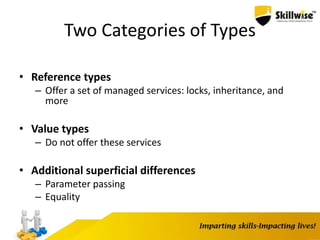
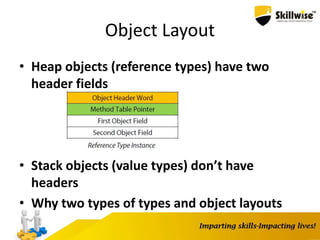



















![Pointers and Pinning
• We want to go from byte[]to byte*
• When getting a pointer to a heap object, what if the GC moves it?
• Pinning is required
byte[] source = ...;
fixed(byte* p = &source)
{
...
}
• Directly manipulate memory
*p = (byte)12;
int x = *(int*)p;
• Requires unsafeblock and “Allow unsafe code”](https://image.slidesharecdn.com/enhancingdotnetapp-150923051627-lva1-app6892/85/Skillwise-Enhancing-dotnet-app-26-320.jpg)


![The Pointer-Free Approach
TcpHeaderRead(byte[] data, intoffset)
{
MemoryStreamms= new MemoryStream(data);
BinaryReaderbr= new BinaryReader(ms);
TcpHeaderresult = new TcpHeader();
result.SrcIP= br.ReadUInt32();
result.DstIP= br.ReadUInt32();
result.SrcPort= br.ReadUInt16();
result.DstPort= br.ReadUInt16();
return result;
}](https://image.slidesharecdn.com/enhancingdotnetapp-150923051627-lva1-app6892/85/Skillwise-Enhancing-dotnet-app-29-320.jpg)

![Using Pointers
• Pointers can help by casting
fixed (byte* p = &data[offset])
{
TcpHeader* pHeader= (TcpHeader*)p;
return *pHeader;
}
• Very simple, doesn’t require helper routines](https://image.slidesharecdn.com/enhancingdotnetapp-150923051627-lva1-app6892/85/Skillwise-Enhancing-dotnet-app-31-320.jpg)
![A Generic Approach
• Unfortunately, T*doesn’t work –T must be blittable
unsafe T Read(byte[] data, int offset)
{
fixed (byte* p = &data[offset])
{
return *(T*)p;
}
}
• We can generate a method for each T and call it when necessary
– Reflection.Emit
– CSharpCodeProvider
– Roslyn](https://image.slidesharecdn.com/enhancingdotnetapp-150923051627-lva1-app6892/85/Skillwise-Enhancing-dotnet-app-32-320.jpg)




![List<T>
• Dynamic (resizable) array
– Doubles its size with each expansion
– For 100,000,000 insertions: [log 100,000,000] = 27
expansions
• Insertions not at the end are very expensive
– Good for append-only data
• No specialized lookup facility
• Still no per-element overhead](https://image.slidesharecdn.com/enhancingdotnetapp-150923051627-lva1-app6892/85/Skillwise-Enhancing-dotnet-app-37-320.jpg)





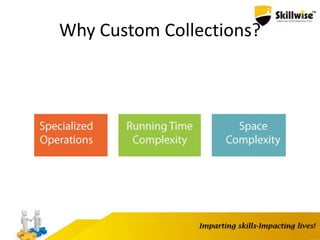
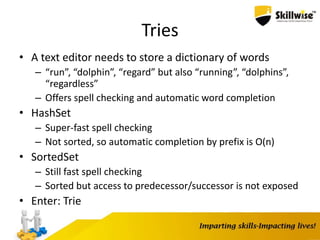
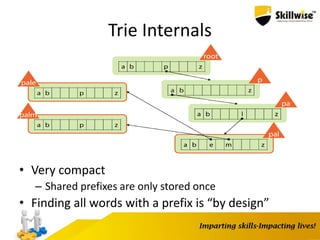


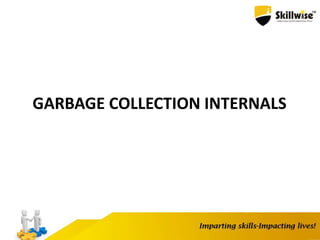














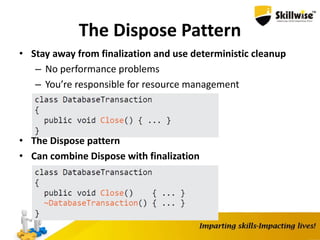










![Task.WhenAll
Task<string>[] tasks = new Task<string>[] {
m_http.GetStringAsync(url1),
m_http.GetStringAsync(url2),
m_http.GetStringAsync(url3)
};
Task<string[]> all = Task.WhenAll(tasks);
string[] results = await all;
// Process the results](https://image.slidesharecdn.com/enhancingdotnetapp-150923051627-lva1-app6892/85/Skillwise-Enhancing-dotnet-app-74-320.jpg)
![Task.WhenAny
List<Task<string>> tasks = new List<Task<string>>[] {
m_http.GetStringAsync(url1),
m_http.GetStringAsync(url2),
m_http.GetStringAsync(url3)
};
while (tasks.Count> 0)
{
Task<Task<string>> any = Task.WhenAny(tasks);
Task<string> completed = await any;
// Process the result in completed.Result
tasks.Remove(completed);
}](https://image.slidesharecdn.com/enhancingdotnetapp-150923051627-lva1-app6892/85/Skillwise-Enhancing-dotnet-app-75-320.jpg)




























































































